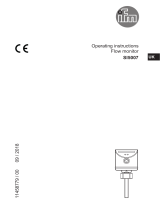
3
UK
10�1�1 Change from menu level 1 to menu level 2 ��������������������������������������23
10�1�2 Locking / unlocking ���������������������������������������������������������������������������24
10�1�3 Timeout ��������������������������������������������������������������������������������������������� 24
10�2 Settings for consumed quantity monitoring �����������������������������������������������24
10�2�1 Configure limit value monitoring with OUT1 �������������������������������������24
10�2�2 Configure limit value monitoring with OUT2 �������������������������������������25
10�2�3 Configure analogue value for volumetric flow �����������������������������������25
10�3 Settings for consumed quantity monitoring �����������������������������������������������25
10�3�1 Configure quantity monitoring via pulse output ��������������������������������25
10�3�2 Configure quantity monitoring via the preset counter �����������������������25
10�3�3 Setting the pulse value ���������������������������������������������������������������������26
10�3�4 Manual counter reset ������������������������������������������������������������������������ 26
10�3�5 Time-controlled counter-reset ����������������������������������������������������������� 27
10�3�6 Deactivate meter reset ���������������������������������������������������������������������27
10�3�7 Configure meter reset using an external signal ��������������������������������27
10�4 Settings for temperature monitoring ����������������������������������������������������������27
10�4�1 Configure limit value monitoring with OUT2 �������������������������������������27
10�4�2 Configure analogue value for temperature ���������������������������������������27
10�5 User settings (optional) ������������������������������������������������������������������������������28
10�5�1 Set standard unit of measurement for volumetric flow ���������������������28
10�5�2 Configuration of the standard display �����������������������������������������������28
10�5�3 Setting the output logic ���������������������������������������������������������������������28
10�5�4 Calibrate curve of measured values �������������������������������������������������28
10�5�5 Reset calibration data ����������������������������������������������������������������������� 28
10�5�6 Setting the start-up delay ������������������������������������������������������������������28
10�5�7 Set measured value damping �����������������������������������������������������������29
10�5�8 Set output status in fault condition ����������������������������������������������������29
10�5�9 Select the medium to be monitored ��������������������������������������������������29
10�6 Service functions ���������������������������������������������������������������������������������������29
10�6�1 Read min/max values for volumetric flow �����������������������������������������29
10�6�2 Reset all parameters to factory setting ���������������������������������������������29
11 Operation ���������������������������������������������������������������������������������������������������������30
11�1 Reading the process value ������������������������������������������������������������������������30
11�2 Change display unit in the Run mode ��������������������������������������������������������30
11�3 Read set parameters ���������������������������������������������������������������������������������31
11�4 Fault indications �����������������������������������������������������������������������������������������31























